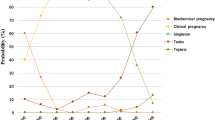Abstract
Purpose
To investigate the stability and repeatability of electrochemiluminescence immunoassay (ECLIA) for beta-hCG detection in embryo spent culture media. To evaluate the correlation between the viability of preimplantation embryo and beta-hCG profile by the new assay.
Methods
In a retrospective study, a total of 357 spent culture media from day1 to day5 were individually collected and quantified by ECLIA. The blank controls and reliability test were performed with normal saline/pure culture media.
Results
1) There was no detectable amount of beta-hCG in blank controls. A high degree of linearity (R2 = 0.995) was found in this study; intra-assay and inter-assay coefficient of variation were 4.87 % and 6.25 %. 2) A significantly higher concentration of beta-hCG was found at day5 group than it at day3 group, both in total samples (1.47 ± 0.68mIU/ml vs 0.55 ± 0.32mIU/ml) and in homologous embryo samples (1.43 ± 0.91mIU/ml vs 0.52 ± 0.23mIU/ml). 3) There was a positive correlation between beta-hCG concentration and implantation rate (r = 0.559 at day3 and 0.535 at day5) or blastocyst morphological grading (r = 0.411).
Conclusions
ECLIA may be an optimal choice for detecting beta-hCG in spent culture media to assess embryo viability, indicating secreted beta-hCG as a useful biomarker for embryo selection in IVF-ET procedure.


Similar content being viewed by others
References
Seli E, Sakkas D, Scott R, Kwok SC, Rosendahl SM, Burns DH. Noninvasive metabolomic profiling of embryo culture media using Raman and near-infrared spectroscopy correlates with reproductive potential of embryos in women undergoing in vitro fertilization. Fertil Steril. 2007;88:1350–7.
Fishel SB, Edwards RG, Evans CJ. Human chorionic gonadotropin secreted by preimplantation embryos cultured in vitro. Science. 1984;223:816–8.
Lopata A, Oliva K, Stanton PG, Robertson DM. Analysis of chorionic gonadotrophin secreted by cultured human blastocysts. Mol Hum Reprod. 1997;3:517–21.
Ramu S, Acacio B, Adamowicz M, et al. Human chorionic gonadotropin from day 2 spent embryo culture media and its relationship to embryo development. Ferti Steril. 2011;96(3):615–7.
Veeck LL. An atlas of human gametes and conceptuses: An illustrated reference for assisted reproductive technology. New York: Parthenon Publishing; 1999.
Gardner DK, Schoolcraft WB, Jansen R, et al., editors. In vitro culture of human blastocyst. Toward reproductive certainty: Fertility and genetics beyond 1999: The plenary proceedings of the 11th worth congress on in vitro fertilization and human reproductive genetics. Pearl River, NY: Parthenon; 1999. p. 378–88.
Macas E. Metabolic status of oocyte and IVF success- is there a relationship? J Fertil Reprod. 2006;4:16–8.
Paternet G, Wetzels AM, Thonon F, Vansteenbrugge A, Willemen D. Intra-and inter-observers analysis in the morphological assessment of early stage embryos during an IVF procedure: A multicentre study. Reprod Biol Endocrinol. 2011;9:127.
Bard AJ, editor. Electrogenerated chemiluminescence. New York: Marcel Dekker; 2004.
Woodward BJ, Lenton EA, Turner K, Grace WF. Embryonic human chorionic gonadotrophin secretion and hatching: Poor coorelation with cleavage rate and morphological assessment during preimplantation development in vitro. Hum Reprod. 1994;9(10):1909–14.
Botros L, Sakkas D, Seli E. Metabolomics and its application for non-invasive embryo assessment in IVF. Mol Hum Reprod. 2008;14:679–90.
Conflict of interest
The authors declared no conflict of interest.
Financial support
This study was supported by the Science Foundation of Guangdong Province (2009B030801022) and Nature Science Foundation of China (2008; no.30872762).
Author information
Authors and Affiliations
Corresponding author
Additional information
Capsule The concentration of beta-hCG detected by highly sensitive ECLIA in culture media positively correlated with blastocyst morphological grading and implantation ability, which may make it as a useful biomarker for assessing embryo viability in clinical procedure.
Rights and permissions
About this article
Cite this article
Xiao-yan, C., Jie, L., Dang, J. et al. A highly sensitive electrochemiluminescence immunoassay for detecting human embryonic human chorionic gonadotropin in spent embryo culture media during IVF-ET cycle. J Assist Reprod Genet 30, 377–382 (2013). https://doi.org/10.1007/s10815-012-9923-7
Received:
Accepted:
Published:
Issue Date:
DOI: https://doi.org/10.1007/s10815-012-9923-7




